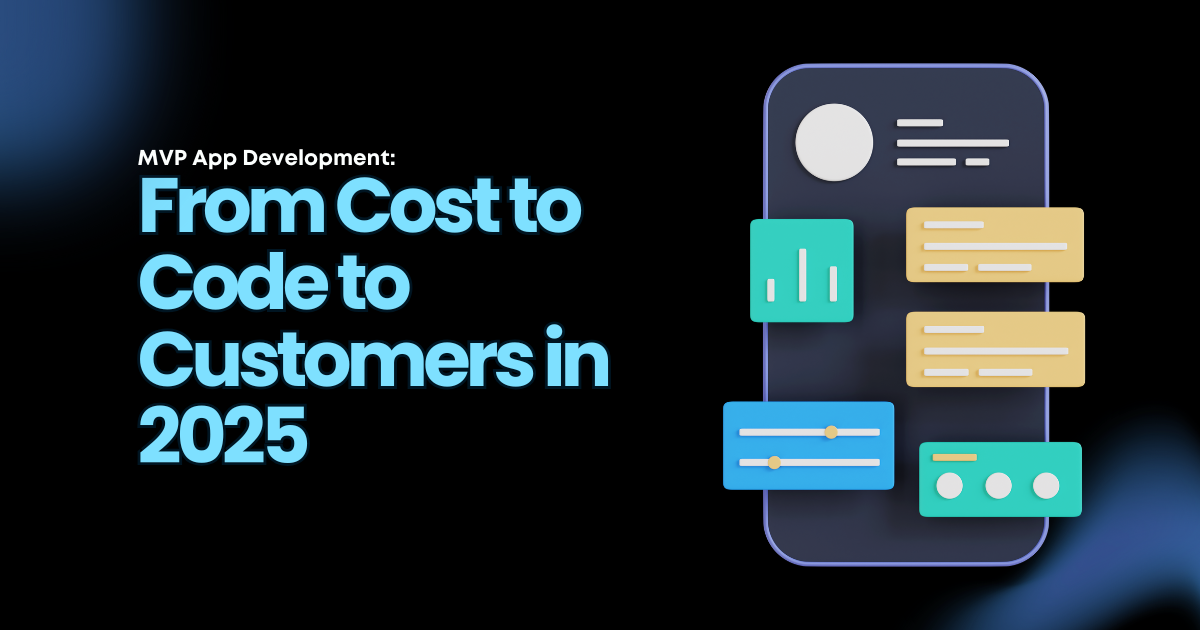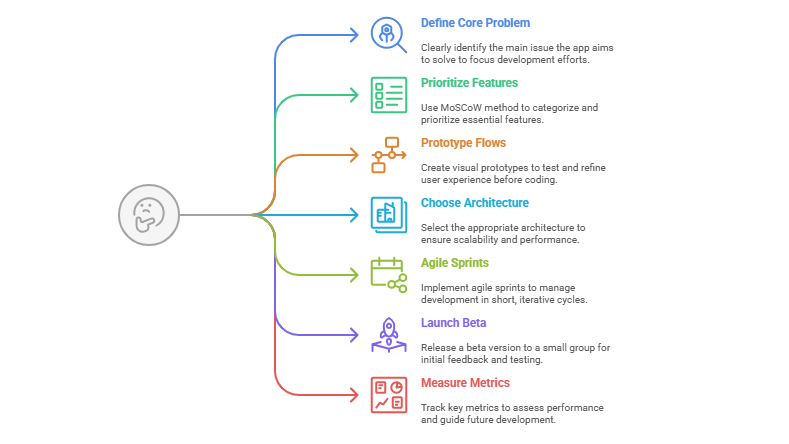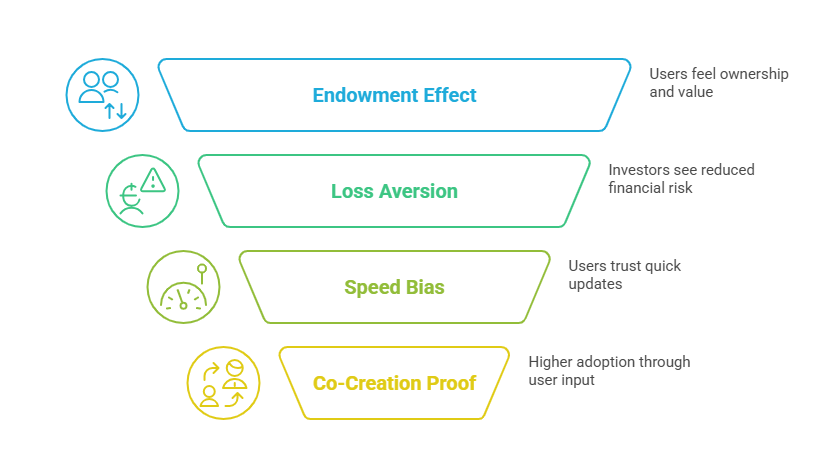
MVP app development is the fastest way to turn an idea into a testable product that wins users and attracts investors.
In 2025, the mobile app market is both massive and unforgiving. Statista projects that global app revenues will surpass $613 billion this year, but most new apps never survive beyond 12 months. The reason is simple: building a full-scale app before validating demand is a bet too many founders lose.
That’s where MVP app development steps in. By creating a minimum viable product, an app with only the core features needed to test the idea, founders reduce risk, save cost, and learn directly from users. Investors now expect this approach, users prefer it, and development practices have matured to make MVP apps more powerful than ever.
At EnactOn, we’ve seen this shift first-hand. A few years ago, founders asked if they should build MVP apps. In 2025, they ask how quickly they can launch one before competitors or burn rates catch up.
Why Founders, Users, and Investors All Love MVP Apps
What makes MVP app development the real MVP is that it meets three groups where they are.
● Founders: An MVP app removes guesswork. Instead of investing $200,000+ into a full build, they can validate ideas with $20,000–$80,000 and pivot based on data.
● Users: People want to feel heard. When early adopters give feedback that actually shapes the next version, they feel like co-owners. That sense of influence creates loyalty.
● Investors: Pitch decks don’t move capital anymore.According to Founder Institute’s 2025 benchmarks, 70% of seed investors now require clear evidence of traction, even from pre-revenue startups, before committing capital. A live MVP that demonstrates real user engagement and market validation is now the entry ticket for serious funding discussions, far outweighing any static PDF presentation
The psychology explains why MVP apps are so sticky. Users forgive imperfections if they see progress. Founders sleep better knowing they’re learning faster than they’re spending. Investors prefer small bets with proof to blind faith in big budgets.
What an MVP App Really Means in 2025
An MVP app isn’t a prototype and it isn’t the full product either. It sits in the middle, in the only place where real validation happens.
A prototype can show you what something might look like. A full product can cost you months of work and capital before you know if anyone cares. An MVP app is different. It’s functional, focused, and built to answer one question: will people use this enough to come back?
In 2025, MVP apps are also expected to stand on their own. They can’t just be throwaway tests. The smartest founders build MVPs with strategies that solve one problem clearly today, but are structured to grow tomorrow. Minimal isn’t the same as temporary.
Here’s the distinction:
| Factor | Prototype (Mockup) | MVP App (Validation) | Full App (Scale) |
| Purpose | Visualize an idea | Test demand with real users | Deliver complete experience |
| Features | Clickable mockups only | Minimal but functional | Fully integrated |
| Timeline | 1–2 weeks | 8–14 weeks | 12–18 months |
| Cost (2025) | <$10k | $20k–$80k | $200k+ |
| Data | Opinions | Real usage & retention | Growth metrics |
The difference matters. A prototype tells you if users like the idea. An MVP app shows whether they use it.
Where MVP Apps Are Winning the Hardest Battles
Not every industry depends equally on MVP apps for survival, but certain sectors rely heavily on them to validate market demand and attract investor confidence. According to CB Insights, 42% of startups fail because they build products that do not meet market needs, highlighting the critical importance of MVPs in early validation. Industry-specific failure rates underline this disparity: while the average startup failure rate is around 90%, healthtech startups face an 80% failure rate and fintech startups backed by investors see about a 75% failure rate. These industries rely more on MVPs to prove product-market fit and survive, unlike sectors with relatively lower failure rates like manufacturing (51%) or construction and retail (53%). This demonstrates how MVP traction is crucial for startups operating in sectors demanding rapid market testing and validation to survive and secure funding.
● Fintech: MVPs validate trust features (logins, KYC, simple transactions) before investing in compliance-heavy systems.
● Healthtech: MVPs test engagement with HIPAA/GDPR-aware setups before scaling into full platforms.
● Edtech: MVPs check learning retention through gamified features before expanding into larger course libraries.
● Consumer Social: MVPs test engagement loops like messaging, likes, or group chats before layering in feeds and algorithms.
● Marketplaces: MVPs validate buyer-seller interactions with minimal flows before adding payments, escrow, or reviews.
Business of Apps reported that fintech and healthtech app downloads grew 25% in 2024, making them two of the hottest spaces for MVP app development in 2025.
The Price of Speed: Breaking Down MVP App Costs
MVP app development cost in 2025 usually falls between $20,000 and $80,000.
Where the money goes:
● Design & UX (15–20%): Polished flows prevent churn; wireframes alone don’t.
● Frontend & Backend (40–50%): Core logic, APIs, and performance matter most here.
● Cloud Infrastructure & DevOps (10–15%): AWS, Firebase, or GCP ensure smooth scaling.
● QA & Testing (10–15%): No one forgives broken logins or crashed checkouts.
● Analytics Setup (10%): Mixpanel or Amplitude from day one ensures you learn, not guess.
Factors That Push Costs Up or Down
● App type: Social MVPs are cheaper; fintech MVPs can cost more with compliance.
● Tech stack: Cross-platform tools like Flutter save 30–40% compared to building native twice.
● Region: Development in North America costs 3–4x more than South Asia.
● Complexity: Adding AI features, chatbots, or wallets can increase cost by 20–30%.
At EnactOn, we treat cost as a strategy, not a number. We’ve seen cheap MVPs become the most expensive mistakes when they force rebuilds. We build MVP apps that can evolve into full products, not disposable experiments.
How to Build an MVP App Without Drowning in Features
Our experience has taught us that the success of MVP app development depends less on speed and more on discipline. Many founders think “minimal” means stripping everything down. In reality, minimal means focusing only on what matters most to users. Here’s the process, step by step.

1. Define the Core Problem Clearly
Every MVP starts with one sharp problem statement. Avoid vague goals like “make learning easier.” Be precise: “Parents can’t find qualified tutors instantly.” A single sentence forces clarity and ensures the app solves something concrete.
2. Prioritize Features With MoSCoW
When figuring out how to create MVP application, one very important thing to remember is that not every feature deserves a place in the first build. Use the MoSCoW framework:
- Must-have: The core action your app is built around (e.g., search and book a tutor).
- Should-have: Features that add value but aren’t essential yet (e.g., profiles).
- Could-have: Extras that can wait until later versions (e.g., rating system).
- Won’t-have (for now): Ambitious features that distract from validation (e.g., AI-driven matching).
This avoids bloated MVPs and keeps costs aligned.
3. Prototype Flows Before Writing Code
A clickable prototype in Figma or Proto.io can reveal usability gaps before a single line of code is written. Testing flows with even 10–15 potential users can prevent expensive rework later. Prototypes are where assumptions get challenged.
4. Choose the Right Architecture
Your technology stack is a strategic decision:
- Flutter or React Native: Faster to launch, cost-effective across iOS and Android.
- Native (Swift, Kotlin): Better performance and security, but higher cost.
- Low-code platforms (Adalo, OutSystems): Ideal for ultra-simple MVPs, not for complex scaling.
The choice affects not just the MVP app development cost but also how easily you can evolve later.
5. Build in Agile Sprints
Break the project into two-week sprints. Each sprint delivers a working slice, not just tasks. This rhythm keeps momentum, allows constant feedback, and avoids the trap of disappearing into long development cycles.
6. Launch a Beta With a Small Group
Go live with a controlled set of users. Keep it small enough to manage feedback but real enough to test behavior. Early adopters are more forgiving and more vocal, which is exactly what an MVP app needs.
7. Measure What Matters
Downloads are vanity. Retention, churn, and feature adoption are reality. Track Day 1, Day 7, and Day 30 retention rates. Observe which features users touch first and which they ignore. These metrics tell you what to improve, add, or drop.
Why this process matters:
Following these steps ensures your MVP isn’t just a smaller version of a full app but a sharper one. For anyone asking how to build an MVP app or how to create MVP application in 2025, this is the blueprint: solve one problem clearly, learn from real users, and evolve without wasting capital.
Under the Hood: Tech Choices That Decide Whether You Scale or Stall
Technical architecture is what separates disposable MVPs from scalable MVPs.
● Cloud-native setups: AWS Amplify, Firebase, Azure streamline scaling.
● Microservices vs monolith: Microservices keep apps modular, easier to expand.
● Databases: NoSQL for flexibility, SQL for transactional strength.
● Analytics stack: Mixpanel, Amplitude, Firebase Analytics must be live from v1.
● Push notifications & A/B testing: Increase retention loops early.
EnactOn emphasizes builds that scale when setting a framework for how to create MVP application. Every MVP we deliver is designed to grow into a full product without code being thrown away.
The Traps That Kill MVP Apps Before They Even Launch
Most MVP apps fail because of predictable traps, not bad ideas. Read that again!
● Adding too many features dilutes validation.
● Misreading vanity metrics leads founders astray.
● Skipping compliance invites lawsuits in fintech or health.
● Treating MVP code as disposable forces costly rebuilds.
● No iteration plan leaves the MVP stagnant after launch.
We’ve watched fintech MVPs fail not because of features, but because users didn’t trust the login screen. We’ve seen social MVPs succeed because they focused only on group chat and nailed it. Discipline is the deciding factor.
The Psychology Behind MVP Adoption: Why Imperfect Wins
The psychology of MVP app development explains why simple, imperfect versions often win more loyalty than polished products.

1. Endowment Effect
● Users value apps more when they feel ownership in shaping them.
● When feedback directly influences feature updates, users believe the app is partly theirs.
● This co-creation loop increases retention and word-of-mouth adoption.
2. Loss Aversion
● Investors think in terms of risk. A $30k MVP app failure is far easier to accept than a $300k full build that flops.
● This is why seed funds and accelerators increasingly demand MVP traction before funding, as it limits downside.
● MVP apps are not just development tools, they are financial risk shields.
3. Speed Bias
● Users forgive bugs if they see quick updates and progress.
● In fact, visible iteration builds trust, signaling that the team is listening and improving.
● Apps that update weekly often achieve higher Day 30 retention than those that wait months to push fixes.
4. Proof Through Co-Creation
● Harvard Business Review found products co-created with users have 20% higher adoption.
● MVP apps thrive here because they are built to evolve with user input, not in isolation.
● The psychology is simple: people stick with what they helped build.
Takeaway: MVP apps succeed not despite their imperfections, but because of them. By tapping into user ownership, investor caution, and the human preference for progress over perfection, MVP app development creates loyalty loops that full-scale builds often miss.
App MVP Examples You Rarely Hear About
Big names prove the point, but it’s the lesser-told MVP app example that teaches most.
Duolingo
● Started as a lightweight flashcard MVP teaching vocabulary in just a few languages.
● What stood out was gamification: streaks, points, and rewards made practice addictive.
● The MVP validated that playful design could drive daily learning habits.
● Today, Duolingo has 500M+ users, but its core loop is the same one tested in that MVP.
Robinhood
● Launched as a waitlist-only MVP to measure demand for commission-free trading.
● The waitlist created anticipation and gave the team concrete proof of interest.
● Scaling was gradual, with infrastructure built in step with demand.
● That careful start transformed Robinhood from invite-only to a mainstream brokerage.
UberCab (early Uber)
● The first MVP worked only in San Francisco and only booked black cars.
● Narrow focus allowed fast learning: would people use an app to request rides?
● By starting small, the team tested operations and user behavior with low risk.
● Once validated, expansion beyond one city turned Uber into a global model for urban transport.
Each one began with a focus on a single core feature. Not a suite, not a roadmap. Just one problem solved. Just one.
How Pros Are Building MVP Apps in 2025
The playbook has changed. Pros that set the MVP app example are leaning on new tools and practices.
● AI copilots reduce coding hours by 25–35%.
● Design-to-code platforms let non-technical founders prototype flows.
● Cross-platform frameworks save money and time on dual-platform builds.
● Beta acquisition hacks: early communities on Discord, invite-only launches, Product Hunt drops.
● Analytics-first builds ensure pivots are guided by data, not gut instinct.
What Investors Really Want to See in Your MVP App
Funding now flows toward metrics, not decks.
Investors check:
● Daily Active Users (DAU)
● Day 7 and Day 30 retention
● Feature adoption rates
● Net Promoter Score (NPS)
According to Founder Institute benchmarks in 2025, 67% of apps that secured Series A funding had user retention rates above 30% at Day 30. This strong retention metric is considered a key signal of product-market fit and user engagement that investors rely on heavily when committing funds at the Series A stage.
What’s Next: The Future of MVP Apps Beyond 2025
MVP app development is evolving faster than ever.
● AI-generated MVPs: Auto-code reduces timelines by weeks.
● Web3 MVPs: Wallets and tokenization baked into early builds.
● AR/VR MVPs: Lightweight immersive testing for consumer apps.
● No-code MVPs: 4-week validations for ultra-fast pivots.
The definition of “minimum viable” keeps shifting, but the principle remains: prove fast, scale smart.
Inside EnactOn: How We Build MVP Apps That Last
At EnactOn, we approach MVP app development as the first chapter of scale, not a throwaway.
Our approach:
● Scope clarity: Focus on one problem that matters.
● Feature prioritization: Control MVP app development cost without sacrificing learning.
● Modular builds: Future-proofing so MVP code grows with you.
● Cross-domain expertise: Fintech, healthtech, edtech, consumer apps.
● Analytics baked in: Investor-ready data from day one.
We’ve built MVP apps that reached thousands of users in weeks, pivoted within 90 days, and scaled into funded startups. Every one of them started as a disciplined MVP, not a full build.
FAQs
What is MVP app development?
MVP app development is building a minimal app with only essential features to test demand quickly.
How to build an MVP app in 2025?
Define the problem, prioritize features, prototype, choose architecture, build in sprints, and test with beta users.
What is MVP app development cost in 2025?
Costs range from $20,000–$80,000, depending on app type, compliance, and tech stack.
What are successful app MVP examples?
Duolingo, Robinhood, and early UberCab all launched MVP apps before scaling.
How do MVP apps attract investors?
They prove traction through metrics like retention, DAU, and NPS, which investors prioritize.
MVP App Development 2025: Takeaway
MVP app development in 2025 is the smartest way to validate ideas, attract investors, and build loyal customers.
From cost to code to customers, MVP apps provide speed, clarity, and proof in markets where failure is expensive and time is short.
At EnactOn, we don’t build disposable prototypes. We build MVP apps designed to grow, backed by analytics, compliance, and scalable architecture. That’s why founders trust us to move them from idea to traction without wasting their runway.
